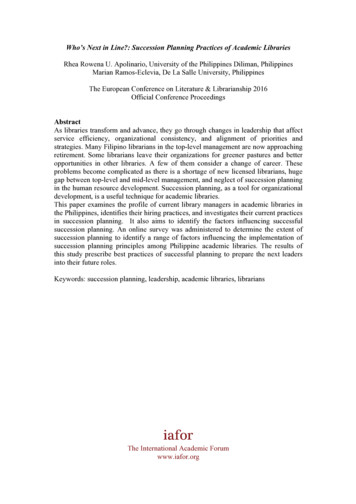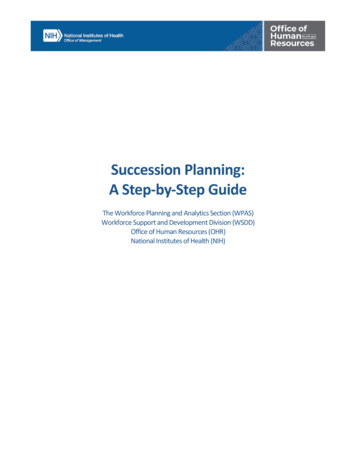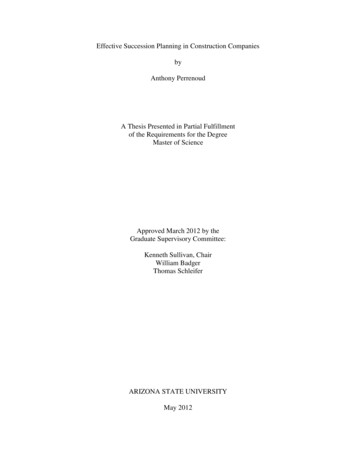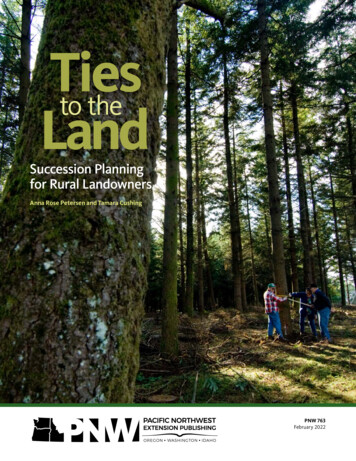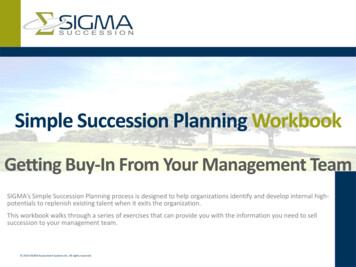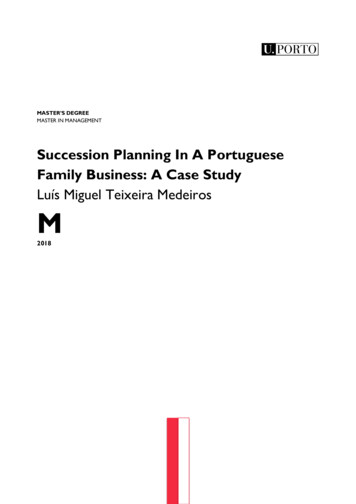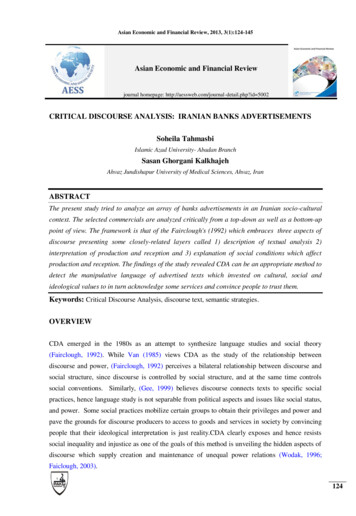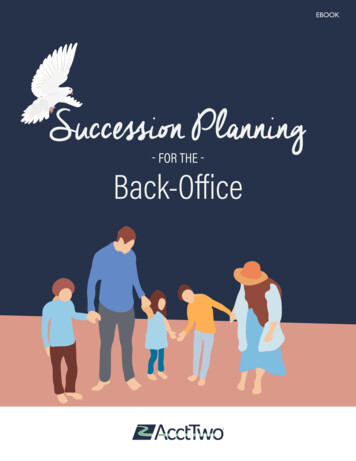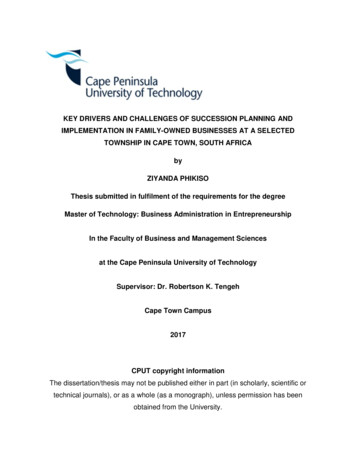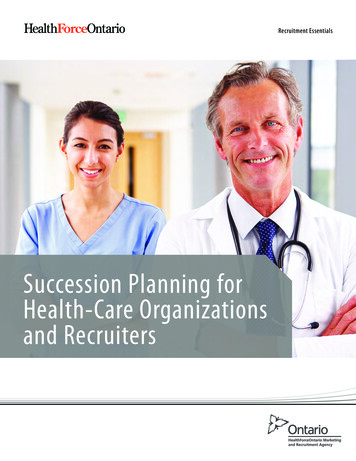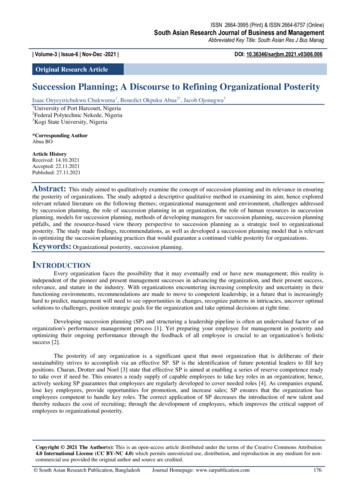
Transcription
ISSN 2664-3995 (Print) & ISSN 2664-6757 (Online)South Asian Research Journal of Business and ManagementAbbreviated Key Title: South Asian Res J Bus Manag Volume-3 Issue-6 Nov-Dec -2021 DOI: 10.36346/sarjbm.2021.v03i06.006Original Research ArticleSuccession Planning; A Discourse to Refining Organizational PosterityIsaac Onyeyirichukwu Chukwuma 1, Benedict Okpuku Abua2*, Jacob Ojonugwa31University of Port Harcourt, Nigeria2Federal Polytechnic Nekede, Nigeria3Kogi State University, Nigeria*Corresponding AuthorAbua BOArticle HistoryReceived: 14.10.2021Accepted: 22.11.2021Published: 27.11.2021Abstract: This study aimed to qualitatively examine the concept of succession planning and its relevance in ensuringthe posterity of organizations. The study adopted a descriptive qualitative method in examining its aim; hence exploredrelevant related literature on the following themes; organizational management and environment, challenges addressedby succession planning, the role of succession planning in an organization, the role of human resources in successionplanning, models for succession planning, methods of developing managers for succession planning, succession planningpitfalls, and the resource-based view theory perspective to succession planning as a strategic tool to organizationalposterity. The study made findings, recommendations, as well as developed a succession planning model that is relevantin optimizing the succession planning practices that would guarantee a continued viable posterity for organizations.Keywords: Organizational posterity, succession planning.INTRODUCTIONEvery organization faces the possibility that it may eventually end or have new management; this reality isindependent of the pioneer and present management successes in advancing the organization, and their present success,relevance, and stature in the industry. With organizations encountering increasing complexity and uncertainty in theirfunctioning environments, recommendations are made to move to competent leadership, in a future that is increasinglyhard to predict, management will need to see opportunities in changes, recognize patterns in intricacies, uncover optimalsolutions to challenges, position strategic goals for the organization and take optimal decisions at right time.Developing succession planning (SP) and structuring a leadership pipeline is often an undervalued factor of anorganization's performance management process [1]. Yet preparing your employee for management in posterity andoptimizing their ongoing performance through the feedback of all employee is crucial to an organization's holisticsuccess [2].The posterity of any organization is a significant quest that most organization that is deliberate of theirsustainability strives to accomplish via an effective SP. SP is the identification of future potential leaders to fill keypositions. Charan, Drotter and Noel [3] state that effective SP is aimed at enabling a series of reserve competence readyto take over if need be. This ensures a ready supply of capable employees to take key roles in an organization; hence,actively seeking SP guarantees that employees are regularly developed to cover needed roles [4]. As companies expand,lose key employees, provide opportunities for promotion, and increase sales; SP ensures that the organization hasemployees competent to handle key roles. The correct application of SP decreases the introduction of new talent andthereby reduces the cost of recruiting; through the development of employees, which improves the critical support ofemployees to organizational posterity.Copyright 2021 The Author(s): This is an open-access article distributed under the terms of the Creative Commons Attribution4.0 International License (CC BY-NC 4.0) which permits unrestricted use, distribution, and reproduction in any medium for noncommercial use provided the original author and source are credited. South Asian Research Publication, BangladeshJournal Homepage: www.sarpublication.com176
Isaac Onyeyirichukwu Chukwuma et al., South Asian Res J Bus Manag; Vol-3, Iss-6 (Nov-Dec, 2021): 176-184According to Armstrong [5], good SP gives careful consideration to a range of issues including transparency,development of potential talent, the dilemmas of internal versus external successors, retention, the overall managementand execution of such plans. If you don’t plan the succession of an organization well, it will mostly fail sooner or later,the greatest tragedy is closely held in organizations that often time’s succession is not thoughtfully planned andcommunicated in an organization [6]. Appraisal of employees is very essential in SP as it has a bearing on the futureperformance or continuity of an organization. SP enhance competent employee availability for future task.Within the informal and formal sectors, skills should be transferred; the existence of a lacuna for any necessaryskill could lead to the proliferation of its products, loss of market share, and ultimately liquidation of the organization.Hence, this research evaluates the potency of SP as an influence on the posterity of organizations.STATEMENT OF PROBLEMMammat [7] states that SP must be a key organizational strategy; managing an organization risk should be at alllevels, however, SP often receives little attention and the board does not allocate sufficient resources to address it, yet itis a primary component of good corporate governance. In the light of this, the high rate of failure inherent inorganizations as a result of lack of qualified managers or employees to take up key roles and perform optimally due tomiss-understood, unfunded and unjustifiable SP system leading to unattained organization objectives has necessitatedthis study.STUDY OBJECTIVEThis study aims to qualitatively examine the concept of SP and its relevance in ensuring the posterity oforganizations. The method utilized by this study is the descriptive qualitative method.The remaining sections of this study will explore the following themes; organizational management andenvironment, challenges addressed by SP, role of SP in organization, role of human resources in SP, models for SP,methods of developing managers for SP, SP pitfalls, resource-based view theory perspective to SP as a strategic tool toorganizational posterity, discussion, findings, recommendations, and conclusion.The organizational management and environmentBernard [8] states that in organizations, management is the most influential person(s) to set the tone foroptimizing and managing succession. They make the rules and determine the success or failure of the succession system.Ideally, management incorporates the operation of SP concerns into strategic planning; thus ensuring its importance tothe achievement of the organizational goal. The management team includes qualified employees who have madethemselves relevant in specific areas. He also opinioned that management has contributed significantly to the collapse ofthe transition of succession to the next organizations' successors, through;i.Provision of limited career growth opportunities.ii. Non-transparency in the succession process.iii. Ambiguous organizational missions and objectives.He further noted that organizational posterity requires generation to generation transitions. Timeliness in thetransition is essential; however, the current management may be unwilling to hand over control and authority at theappointed time to successors. Alternatively, the next successors are not competent to assume responsibility.Another point identified by Bernard [8], states that the organization may not provide opportunities that fitemployees’ strengths; thereby, making the employees possess skills or knowledge not necessary to the available position.Finally, Abonifoh et al. [9] note that continuous change in the environments affects organizations especially asit concerns SP. The changes are diverse and pervasive: technological factors, public policies, economic conditions, tradeunion influences, competitions, suppliers, demographic changes, political-legal factors, social-cultural variables. Changeshould be managed simultaneously with attention to the management of SP.CHALLENGES ADDRESSED BY SUCCESSION PLANNINGThe challenges addressed through SP as identified by Nzuve [10]; Pandey & Sharma [11]; Sweeney [12]features.A.LeadershipTo create a powerful cadre of leaders that has the capacity and capability to sustain the achievement oforganizational strategic and operational objectives. To provide the necessary support through training, coaching,mentoring, and performance measurement for team leaders to enable the delivery of the operational objectives, including,creating succession opportunities into higher-level roles. South Asian Research Publication, BangladeshJournal Homepage: www.sarpublication.com177
Isaac Onyeyirichukwu Chukwuma et al., South Asian Res J Bus Manag; Vol-3, Iss-6 (Nov-Dec, 2021): 176-184B.Technical SkillsThe need to attract, manage and retain critical skills to fill positions that disproportionately contribute toorganizational success. Moreover, complex roles (for example auditors, investigators, and risk analysts/ profilers) requirehigh-end skills which are often difficult to attract inside the organization due to a shortage in skills within the country.Hence, the necessity for organizations to implement a talent attraction and retention strategy that differentiates thetechnique to managing these critical high-end skills from other skills and roles in the organization.C.CultureTo engender the behaviour and practices that facilitate ownership and accountability for the achievement oforganization and individual performance and the building of a robust organizational structure that supportsprofessionalism, integrity, service, and a learning environment. The culture must drive employees towards a positiveenterprising attitude fuelled by an urge for learning and self-development. Collectively, these attitudes and culture mustdrive a strong service ethic.Role of succession planning in organizationAccording to Fulmer [13], the demand for effective managers continues to grow; the retirement of babyboomers is producing a sharp decline in the ranks of available personnel. Also, tomorrows’ executives need to becompetent in initiating technological and global ideas. Hence, the need for strategic replacement plans for roles in allorganizational cadres.Furthermore, Groves [14]; the treasury board of Canada secretariat [15] identified its role to the organization toinclude;i.Enhancement of employee engagement.ii.Development of potentially optimized employees to fill significant roles.iii.A recognition and involvement of employees by management.iv.Strategies to exploit strategic knowledgev.Benefits in observing equity in organization goal achievement.vi.Increased competence to actualize organizational goals.Role of human resources in succession planningDeborah [16] states that SP should be owned by line managers, and should be actively led by the chief executivewho has a key role in ensuring that it is given the importance it deserves by other senior managers; ensuring that thecontinuity of a healthy pipeline of potential leaders is necessary for the posterity of the organization. But the CEOsshould not possess sole responsibility. Hence, the human resource function possesses a vital function in navigating theprocess and involving the relevant parties. When the need for a move at the management cadre is engaged, the humanresource shall ensure that all requirements are actualized and communicated to a SP committee [17-18]. Human resourcedepartments also provide career counseling services to employees [11]. The human resources function is likewisecentrally focused on the development and management of evaluation procedures and information supply, including themaintenance and development of a digitalized database, and management of talents.The core of SP is to synergize future organizations' needs with employees’ capabilities. Retaining talentedemployees entails enabling and engaging them with enriched opportunities. Attracting and retaining competentemployees is becoming a strategic and economic challenge [13].Models for succession planningThe following models for SP have been identified;Model I: the seven-point star model for systematic succession planning and management.Rothwell [19] states that organizations need to plan for talent to assume key leadership positions or backuppositions on a temporary or permanent basis; SP and management are implored to effectively ensure such. He furtherstated that SP should not stand alone; it should be paired with succession management which assumes a more dynamicrole in an organization. The seven-pointed star model for systemic SP and management as articulated by Rothwell [19]includes;Step I: Make the commitment; as illustrated in model 1, the organization decision-maker should commitsystematic succession planning and management (SP and M) and enshrine a SP and M programme; the organizations'decision-makers shouldi. Assess challenges and practices.ii. Evaluates and demonstrate the necessity for the program.iii. Identify the organizations' exact SP and M program requirements. South Asian Research Publication, BangladeshJournal Homepage: www.sarpublication.com178
Isaac Onyeyirichukwu Chukwuma et al., South Asian Res J Bus Manag; Vol-3, Iss-6 (Nov-Dec, 2021): 176-184iv.v.Conduct SP and M meetings as necessary to unveil the program and review the progress continually.Effectively identify employees that need the program.Managers should be counseled about any SP and M challenges in their domain of responsibility [19].Step 2: Assess present work/people requirements; decision-makers should evaluate the current role demands insignificant positions. Hence, employees are sufficiently competent in the established role for advancement. Decisionmakers should identify the vital management post in the firm, and know the needs for effectiveness in the role [19].Step 3: Appraise individual performance; illustrated above as the third step is appraising individual performanceand this refers to how well individuals are currently executing their tasks? The necessity for this is anchored on theassumption that SP and M programs presume that employees are executing their present task sufficiently, hence areapproved for advancement. Also, the organization must have a stock/bench of talent via the available human assets [19].Step 4: Assess future work/people requirements; it refers to a clear statement of the competency or rolerequirements for the vital future leadership positions, hence, decision-makers should be aware of this need. This ensuresfuture leaders adapt to the changing requirements and strategic organizational goals [19].Step 5: Assess future individual potential; to what extent are employees refined for advancement? What talentsare manifest, and how adequately do those talents match up to future task demands? To address these issues, theorganization must enshrine a process to evaluate the future potentials of individuals. The future-oriented procedure mustnot be baffled with present or past-oriented individual performance assessment [19].Step 6: Close the development gap; this step connotes how an organization can meet SP and M goals byinternally developing employees? To answer this issue, the organization must establish a recurrent leadershipdevelopment program to internally culture future leaders. Decision-makers should likewise seek alternatives to traditionalpromotion [19].Step 7: Evaluate the succession planning program. To improve, the SP and M program should be undercontinuous appraisal to evaluate its effectiveness. The outcome of the appraisal may be utilized for continuous programadvancement and to sustain an assurance to systematic SP and M [19].MODEL 2 – THE BEST-IN-CLASS PACE MODELThe use of SP to achieve corporate goals requires a combination of strategic actions, organizational capabilities,and enabling technologies as articulated by the Aberden Group [20].Pressures Driving Succession PlanningTo prepare for the loss of key leaders to retirement and prevent the loss of high potential talent to competitors,and strengthen the pipeline in terms of quantity and quality of successors, Aberdeen’s best-in-class has placed increasedemphasis on SP [20].Leading Best-in-class StrategiesPressures to stave off the loss of high potential talent and improve the quality of next-generation leaders arefocusing organizations to view SP more as key retention and development enabler. As a result, the leading strategies thatBest-in-class is pursuing to address these pressures are establishing a development culture/mindset and improving thecompany’s bench strength for key positions [20].Capabilities and EnablersThe essential ingredients of a SP strategy that produces top results include the proper mix of process,organizational knowledge, technology, and performance measurement.ProcessBest-in-class organizations understand that a standardized approach to employee evaluation and developmenthelps establish and reinforce an organizations’ development culture or mindset. This standardization is critical forcreating consistency; consistency that not only negates potential employee dissatisfaction that results from misalignedexpectations but also reduces errors in employee development plans and successor identification. These work in tandemto improve employee retention [20]. South Asian Research Publication, BangladeshJournal Homepage: www.sarpublication.com179
Isaac Onyeyirichukwu Chukwuma et al., South Asian Res J Bus Manag; Vol-3, Iss-6 (Nov-Dec, 2021): 176-184OrganizationTo pursue SP, senior management buy-in is critical. So is identifying key positions where SP is (or will be)required. Across all organizations surveyed these two capabilities stand out in the understanding of how changes to theorganization (i.e. strategy, goals, or structure) impact the quantity and type of successors needed.Furthermore, Best-in-class organizations leverage more experienced and/or high-performing employees toconnect with and provide guidance to newer workers and/or high potential workers. This not only aids in instilling bestpractice methodology but also helps younger workers connect and build relationships with employees they shouldemulate within their organization [20].Methods of developing managers for succession planningKim [21]; Celestine [22] identify the diverse methods of developing managers, which organizations can alsoimplore to enhance the potency of SP on employees. These methods are grouped into ional methods: this involvesJob rotation: This is executed to enable an employee (trainee) understand the challenges that are peculiar todifferent departments, and likewise enhance opportunities to learn from diverse superiors. This practice facilitatesadequate compression and open communication [22].Coaching: connotes constantly guiding, motivating, and inspiring employees by the management cadre orimmediate supervisor; this facilitates development and growth.Assistant to: denotes a staff function. The employee (trainee) executes assigned tasks and is accountable to asuperior. He understudies and learns from the superior with the aim of taking over such position and role inposterity [22].Multiple management: connotes the utilization of a committee in making decision. This involves theparticipation of diverse management cadre who facilitates the formulation of policies, decision making andexecution [22].Ex-organizational method: this involvesSpecial courses: These are initiated and prepared for the management cadre. In these courses, strategic techniquesin management are analyzed. structured courses include real-life scenarios to enrich the managementunderstanding of responsibilities and achieve optimal results. This method utilizes discussions and lectures.Membership of professional bodies: the journals published by professional bodies expose empirical and practicalfindings in diverse industries. They like reveal recent ideas and techniques, analyses problems and solutions onconference or seminar platforms. Members engage in annual meetings where ideas are exchanged and sources ofstrategic advantages are recommended.Evening programs: Some organizations sponsor their management cadre to attend special managementprogrammes organized by the academia or management consultants.Sensitivity training: The goal of sensitivity training is to enable employees to be sensitive to other’s feelings toachieve a heightened degree of self-awareness and to be more conscious of the short-comings of others. It enablescooperation and accommodation amongst employeesBusiness games: The rationale is to provide employees the chance to make effective decisions in a simulatedsituation. The game is played in a manner that players (i.e. employees) compete in making decision. The group orplayer (i.e. employees) who makes an optimal decision that offers the organization strategic benefits wins thegame. The game revolves around all functional areas of interest to management. The business game equips theplayers to enhance their analytical and critical skills.Membership of a committee: This offers the employee an opportunity to relate and collaborate with experts as ateam. The employees gain exposure to significant and controversial matters and learn how to solve them.Special assignments: This importance on a special assignment enables employee to analyze a challenge andpostulate recommendations. The employee is equipped to understand the strategies needed to handle assignments.The employees learn to be accountable for his/her task and performance. The employee is encouraged to makeinquires and seek the counsel of other employees/managers.SUCCESSION PLANNING PITFALLSKesler [23] identifies these pitfalls to include;i.Bench strength drains optimal utilization of brains.ii.Lack of formal/explicit written action-plan for individual key position.iii.A rigid, inflexible plan not tailored to the abilities and needs of the personnel involved.iv.Execution of succession is exclusively on meeting organizational needs and mostly ignoring employee interest.v.Its procedures may create confusion and lack transparency, which may cause employees to exit.vi.The hiring of outsiders is executed without consultation with insiders. South Asian Research Publication, BangladeshJournal Homepage: www.sarpublication.com180
Isaac Onyeyirichukwu Chukwuma et al., South Asian Res J Bus Manag; Vol-3, Iss-6 (Nov-Dec, 2021): 176-184Resource-based view theory perspective to succession planning as a strategic tool to organizational posterityThe theoretical premise of this research is the resource-based view theory of the firm. The RBV exposes howorganizations’ internal capabilities and resources are associated with sustained competitive niches and advantages [2426]. The RBV theory offers management an effective structure of evaluating potential factors (i.e. SP practices) thatcould be utilized to generate and sustain a niche competitive edge for their organization in their industry. RBV theoryexposition reveals that not all resources are capable of providing a significant advantage that project the optimizedessence of an organization’s mission, hence comprehending the framework of the RBV theory guarantees the effectiveexplorations of organizational resources which are refined to possess valuable, rare, inimitable, and non-substitutable(VRIN) edge [27]. From a RBV spectrum, successful SP can be credited to the competence of building a VRIN resource(i.e. employees) coordinated by the organization and this competence will enhance the optimal performance andsustainable organizational posterity [24, 25].Madhani [28] posits that organizations encounter difficulty in identifying resources that provide success and theones that offer sustainability, much more difficult is to recognize one that offers both simultaneously. In addressing thisobservation, Dasgupta and Gupta [29] assert that management should focus on internal capabilities and resources (i.e.human resources) for success, competitive advantage, and sustainability. Hence, management having been provided aguide on what to focus on, have to invest in acquiring, creating, sharing, and applying strategic knowledge to optimizehuman resources competencies [27], via effective SP practices. Hence, for organizations to achieve a competitive nichein their industry they first have to optimize their internal resources [27]; the sustainability of organizational posterity isanchored on the level of competence that is VRIN. This is further reinforced by Barney [24] who asserts that anorganization attains sustainable posterity when it executes a value-addition strategy (i.e. optimized competencies ofsuccessors) that is VRIN.DISCUSSIONThe volatility of an organizations’ environment may affect the organization indirectly or directly, pressuresmanagement to act effectively toward responding or manipulating these trends. The optimization of effective action bythe management allows the organization to survive another day. These skills possessed by the present management haveto be impacted to the sub-ordinates (potential managers) to arm them properly for tomorrows’ challenges. Managementshould enable employees with a relative free opinion which must be given appropriate consideration and relativeimplementation; this inspires the employee (potential manager) to accept his/her role and stay in the organization. Thus,encouraging a viable transition in the SP process to managers eager and competent, to serve the organization.SP is implemented to aid organizations in avoiding anticipated future needs which are vital to their operation.Firstly, leadership can be taught and learned as a skill to potential managers to ensure that the qualities inherent in it donot depreciate. This is addressed by SP development programs; job rotation, seminars, etc. thereby providing anorganization with appropriate skills for its posterity.Also, a technical skill that is required to handle non-managerial employees is important in an organization as iteffectively accomplishes goals set by the top and middle manager which is also addressed through SP.Furthermore, an organizations’ culture is an essential feature that cannot be neglected, it is vital to everyorganizational beat. SP encourages and sustains healthy culture in organizations for its continuous and smooth operation.In addition, SP addresses challenges of conceptual skills, human skills, current operating practices that ensurecost-benefit, relevant implementation of business ethics, etc. which ensures organizations’ posterity.SP through its proper implementation plays a significant role, which some organizations seek to explore. Itsroles in the organization involve the transfer of relevant skills to next-generation managers, cost-benefit in terms ofreduction in recruitment, enhancing the level of employee development, and encouraging employees’ patriotism for theorganization.The human resources department can effectively enhance the culture of SP in organizations, throughcollaborative efforts with the first-line managers and support from top management, as well as evaluating programs ofother organizations. The human resources through its diverse functions which are primarily centered on the employeedirectly or indirectly enhance organizational posterity via enhancing potential identified talent possessed by theseemployees (potential managers).The models shown in this research highlights core important areas or factors that necessitate the successfulimplementation of SP when utilized. From its outlined features, the researchers developed a model termed “the valiantsuccession model.” Below is the model, its features, and its explanation. South Asian Research Publication, BangladeshJournal Homepage: www.sarpublication.com181
Isaac Onyeyirichukwu Chukwuma et al., South Asian Res J Bus Manag; Vol-3, Iss-6 (Nov-Dec, 2021): 176-184Models-3: The Valiant Succession ModelSource: The AuthorsSTEP 1: Identify the need for succession planning: This is the core area that entails the adoption of other steps.Once the need for SP is known, SP becomes a necessity and managerial responsibility for achieving such need andsatisfying organizational posterity.STEP 2: Evaluate the organization’s capabilities: This involves the strengths and weaknesses inherent in theorganization; gaining top management support, the culture prevalent in the organization, as well as general and strategicinformation associated with the organization's operations.STEP 3: State the benchmark: This denotes setting a standard that will be utilized as a yardstick to assessperformance in the SP program and its effective execution.STEP 4: Identify potential managers: Employees appraisal usually recorded by the human resources departmentenables the knowledge of potential managers through their skills, abilities, achievements, development attained, etc.which is vital to the SP process.STEP 5: Ensure the quality of the trainers and programs: The trainers for the SP program have to be qualified interms of knowledge, technical know-how, experience, and other relevant factors to the SP program. The program itselfmust be in line with the organizational objectives, and purpose of the succession program.STEP 6: Ensure transparency of the appraisal process: This denotes an equal playing field and rule for theparticipants of the SP program, who may evaluate their performance; it reduces bias and unnecessary sentiments.STEP 7: Evaluate the succession planning program: This measures the achievement of the purpose for theprogram; evaluates if its purpose was achieved, if there is a need for adjustment, and make appropriate correction wherenecessary.The methods identified by Celestin [22], exhaustedly treated the impo
planning, models for succession planning, methods of developing managers for succession planning, succession planning pitfalls, and the resource-based view theory perspective to succession planning as a strategic tool to organizational posterity. The study made findings, recommendations, as well as developed a succession planning model that is .
